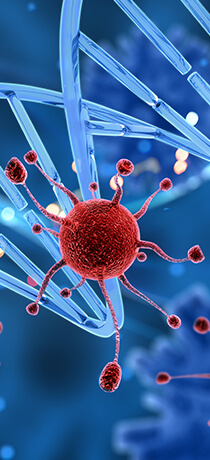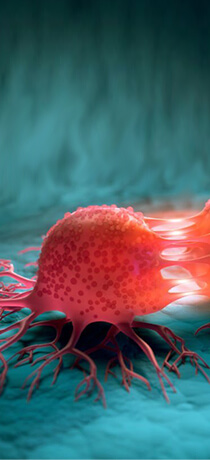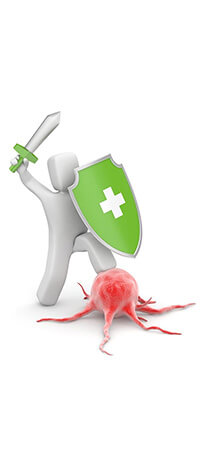 ABOUT CANCER
ABOUT CANCER

Cancer is a disease in which some of the body’s cells grow uncontrollably and spread to other parts of the body. Over 100 types of cancer are prevalent which are different in behavior and response to treatment. Globally, cancer is the second leading cause of death and accounts for 9.6 million deaths in 2018.
One of the most significant challenges of the 21st century in the world today is to understand the burden of growing cancer patients and ways to prevent it. It is first important to understand cancer to manage it effectively.
Humans are complex multicellular organisms made up of trillions of cells, each with its structure and function. And our body is programmed to routinely replenish cells in different organs. As normal cells age or get damaged, they die off and new cells take their place as per the signals given by the genes.
Cancer begins when these genetic changes interfere with this orderly process. When this process is disturbed, cells no longer respond to the signals and begin to grow abnormally. These abnormal cells grow and divide uncontrollably in the body and slowly accumulate to form a tissue mass, lump or growth called a tumor. These abnormal cells can destroy normal body tissue and spread through the bloodstream and lymphatic system.
Cancers are mainly divided into five types based on where it begins:
Uncontrolled cell growth and tumor formation because of the genetic changes are the basic cause of cancer. Few cancers are due to inherited genetic mutations but most cancers are related to environmental, lifestyle, or behavioral exposures.
Signs and symptoms caused by cancer may vary depending on the type of cancer, its location, and its spread to other organs or tissues.
Some general signs and symptoms associated with cancer include:
Here are the facts behind some of the most common cancer myths:
Myth 1: All cancers are the same and can be treated the same way
Fact: All cancers and their treatments are not the same and they do not affect every patient in the same way. In general, a patient receives treatment based on the location of the cancer, whether or how much it has spread, how it is affecting the body functions and the overall health of the patient.
Myth 2: Cancer is contagious
Fact: Cancer is not contagious. Spending time with a loved one who has cancer will not cause you to get it too.
Though cancer does not spread from person to person, certain viruses or bacteria can increase your risk of getting cancer. Certain types of human papillomavirus (HPV) have been known to cause cervical, anal, and some kinds of cancers. Hepatitis B or C spreads through sexual intercourse or infected needles can increase your risk of getting liver cancer.
Myth 3: Biopsy makes cancer spread
Fact: This is a dangerous misconception. There is no appropriate scientific evidence to support this notion. Biopsy benefits the patient in several ways by making accurate staging and relevant treatment planning possible.
Myth 4: Eating sugar makes cancer worse
Fact: Although research has shown that cancer cells consume more glucose (sugar) than normal cells, no studies have shown that eating sugar will make your cancer worse or less sugar intake slows down cancer development.
Myth 5: Cancer is a death sentence
Fact: Even though cancer mortality rates are high, about a third of all cancers can be cured if they are detected and treated early. With a healthy lifestyle, treatment, and regular health check-ups, one can survive for at least five years after the cancer is diagnosed.
Myth 6: No family history of cancer means you are not at risk
Fact: Although having a family history of cancer increases your risk of developing the disease, only 5% to 10% of cancer cases are caused by inherited genetic mutations. The remaining 90% to 95% of cases are caused by the individual's lifestyle and environment, such as smoking or exposure to cancer-causing chemicals, etc.
Myth 7: Superfoods prevent cancer
Fact: While a healthy diet can help improve the way you feel, there is no single food or food group that can provide enough protection against cancer. Some foods like blueberries, beetroot, broccoli, garlic, and green tea are rich in antioxidants that help to remove toxic elements from the body.
Even though cancer is one of the most dreaded diseases, early detection, and specific treatment protocol lead to a success rate of 60-90%. In general, the survival rate and success of treatment for cancer depend on the stage of cancer during diagnosis and the overall health of the patient. Regular screening and health checks would help in early detection. The recent advances in cancer treatment are geared toward positive outcomes.
https://www.who.int/health-topics/cancer#tab=tab_1. Accessed on: 05-10-2020.
What is cancer? https://www.cancer.gov/about-cancer/understanding/what-is-cancer. Accessed on: 05-10-2020.
Worldwide cancer data. https://www.wcrf.org/dietandcancer/cancer-trends/worldwide-cancer-data. Accessed on: 05-10-2020.
Cancer A–Z. https://www.cancer.org/cancer.html. Accessed on: 05-10-2020.
Cancer Basics. https://www.cancer.net/navigating-cancer-care/cancer-basics. Accessed on: 05-10-2020.
Cooper GM. The Cell: A Molecular Approach. 2nd edition. Sunderland (MA): Sinauer Associates; 2000. The Development and Causes of Cancer.
National Institutes of Health (US); Biological Sciences Curriculum Study. NIH Curriculum Supplement Series [Internet]. Bethesda (MD): National Institutes of Health (US); 2007. Understanding Cancer.
https://www.mayoclinic.org/diseases-conditions/cancer/symptoms-causes/syc-20370588 . Accessed on: 05-10-2020.
https://stanfordhealthcare.org/medical-conditions/cancer/cancer.html. Accessed on: 05-10-2020.
The Genetics of Cancer. https://www.cancer.net/navigating-cancer-care/cancer-basics/genetics/genetics-cancer. Accessed on: 05-10-2020.
Common Cancer Myths and Misconceptions. https://www.cancer.gov/about-cancer/causes-prevention/risk/myths. Accessed on: 05-10-2020.
Cancer causes Popular myths about the causes of cancer. https://www.mayoclinic.org/diseases-conditions/cancer/in-depth/cancer-causes/art-20044714. Accessed on: 05-10-2020.
Causes of cancer. Retrieved on 2022, April from https://en.wikipedia.org/wiki/Causes_of_cancer

 CANCER TREATMENT
CANCER TREATMENT

Cancer treatment has an individual or congregation of surgery, radiation, medications, and other therapies to heal cancer, reduce cancer or stop the progression of cancer.
There are many cancer treatments among which you may receive one treatment or a combination of treatments.
Surgical oncologists perform cancer surgeries to remove the tumor or some nearby tissues. Depending upon the purpose of the surgery, the following are some of the types of surgery used in cancer treatment:
Other types include palliative, supportive, and restorative surgeries.
Apart from Open or Minimally invasive surgeries, other surgeries are performed through less invasive techniques. Few among them include:
The robotic device used in surgery are known for having greater dexterity and range of motion than humans have using traditional laparoscopic, or minimally invasive, surgery. This allows surgeons to operate on hard-to-reach parts of the body, and get closer looks at hard-to-see places.
High doses of radiation are used in this treatment procedure to kill cancer cells or shrink tumors. Cancer cell DNA is damaged by using high doses of radiation that kill cancer cells or slow down their growth. Thus, the damaged DNA of cancer cells stops dividing or dies. These damaged cells, when they die are removed from the body. There are two main types of radiation therapy, external beam and internal.
External-beam Radiation Therapy: It is the most common type of radiation therapy. It delivers radiation from a machine outside the body. It can treat large areas of the body if needed. A machine called a linear accelerator, or linac creates the radiation beam for x-ray or photon radiation therapy. Special computer software adjusts the beam’s size and shape. This helps target the tumor while avoiding healthy tissue near the cancer cells.
Internal Radiation Therapy: Internal radiation therapy is also called brachytherapy. This type of radiation therapy is when radioactive material is placed into cancer or surrounding tissue. Implants may be permanent or temporary and may require a hospital stay.
Cancer cells are killed using drugs in chemotherapy type of treatment. There are more than 100 drugs that are used as a part of Chemotherapy, and each of them works in its unique way. But one thing is very clear, these drugs stop the cancer cells from growing.
Chemotherapy is given intravenously. They are also given as a pill, a shot, a skin cream, or a liquid that you can swallow. The benefits of chemotherapy:
Cancers arising from organs such as breasts and prostate, use hormones to grow. Thus, hormone therapy slows down the growth or stops it. Hormone therapy is used to:
Types of hormone therapy: Hormone therapy falls into two broad groups, those that block the body’s ability to produce hormones and those that interfere with how hormones behave in the body.
This type of treatment targets specific cells by helping inhibition of cancer growth, division, or spread. Targeted therapy is a type of cancer treatment that uses drugs designed to "target" cancer cells without affecting normal cells.
Cancer cells typically have changes in their genes that make them different from normal cells. Genes are part of a cell's DNA that tell the cell to do certain things. When a cell has certain gene changes, it doesn't behave like a normal cell. For example, gene changes in cancer cells might allow the cell to grow and divide very quickly. These types of changes are what make it a cancer cell.
This type of treatment allows our immune system to fight cancer during which immunity is boosted. In a healthy human being, the immune system prevents the growth of various kinds of cancer by finding and destroying abnormal cells. For example – The cells of the immune system are found inside or around tumors in the body which means that the immune system is affecting the tumor. These immune system cells are called TILs or Tumor-infiltrating lymphocytes. People whose tumors have these cells do better than those compared to who don’t have them.
Various kinds of immunotherapies are used to treat cancer.
Isotope means two or more forms of the same element that contain equal numbers of protons but different numbers of neutrons in their nuclei, and hence relative atomic mass is different than that of chemical properties. Especially, an element in a radioactive form. Radioisotopes of a particular atom contain an unstable combination of neutrons and protons, which may lead to excess energy (and instability). Medical Isotopes or Radionuclides are radiologically active atoms.
Medical Radionuclides can fall into three major categories. The first is diagnostic, where the radioisotope allows doctors to visualize a tumor’s precise location and contours within the body with greater clarity than an MRI scan provides. Another is therapeutic, where doctors use radionuclides to deliver cancer-killing radiation directly to tumor cells. The third is theragnostic, which combines the power of both in such a way that the theragnostic radionuclide agent allows a doctor to both visualize and treat a tumor simultaneously.
Cancer treatments, depending on the usage are of 4 types:
 FIGHTING CANCER
FIGHTING CANCER

The only thing constant in this universe for a human is the “Struggle”. The struggle while being born, the struggle while growing up, the struggle to lead a happy life, and the struggle to achieve your goals. Everyone’s life has at least a little struggle involved in his/her life.
Holistically, it’s the struggle for survival is the LIFE in itself. Hence, being a patient of cancer is only part of a greater struggle we are dealing with. Therefore, a patient, who is fighting cancer is experiencing Life as a whole and is willing to struggle through the obstacles to reach their bigger goals.
Though cancer is one of the leading causes of death worldwide, every year, millions of people are diagnosed with cancer, and still almost half of the patients eventually survive.
As a potentially life-threatening disease, it is also a condition that is associated with significant fears and concerns. As a result, a diagnosis of cancer can have a profound effect on the individual and their family member’s health and well-being. The patient can experience a rollercoaster of emotions like anxiety, distress, and depression. Though it is normal to feel these emotions after being diagnosed with cancer, at the same time, it is important to recognize these changes and get help when needed.
Surviving cancer is always the goal, but the real test for the cancer patient is how to deal with it?
During the initial days of diagnosis, the patient can experience physical, social, emotional, and psychological changes. Life after a cancer diagnosis depends on how you think it to be. Your perception will become reality. Try to choose the brighter side and avoid judging yourself for your emotions.
The first step in fighting cancer is realizing that you have an issue and having the courage to reach out for help.
Once you have been diagnosed with cancer, it is important to know the details of your condition. Have an open discussion with your doctor and collect basic and useful information about the diagnosis such as cancer location, whether it has spread to other parts, available treatment options, the success rate of each treatment, and the possible side effects.
It is always advisable to seek a second opinion about your condition. This will help you feel confident and comfortable in the diagnosis and treatment plans. Talking to another doctor will also help you in clearing your doubts and provide you with peace of mind.
Getting ready for the treatment schedule and coping with its side effects is the next task. Dealing with cancer treatment may make you physically and emotionally draining. Yet, it is manageable. It is important to prepare yourselves physically and mentally before undergoing the procedure. As the journey continues, these treatments can cause your body to change. Your body may look different and most patients struggle with these changes and the effects they have on self-esteem. Try to accept these changes as part of your cancer journey.
If you suffer from a prolonged sense of mixed emotions and adjustment issues seek help from a psychotherapist, healthcare team, and support group or faith community.
Studies showed that every two minutes, a child somewhere in the world is diagnosed with cancer. When cancer is diagnosed in a child, it not only affects that child but also affects the whole family. A parent is never prepared to hear that their child is diagnosed with such a life-threatening illness. The parents have to handle their emotions and will have to make tough decisions about the treatment plan and should also learn about the medical procedures and clinical visits.
The treatment plan for childhood cancers should be designed to help kids to navigate the challenges that come during their cancer journey. Several hospital visits and treatment schedules may affect your child’s health and make them feel more anxious and fatigued. Seek help from a certified child life therapist to prepare your child for the cancer journey. There are also several advocacy groups worldwide that support cancer patients and their family with adequate and timely assistance. Regular follow-up and healthy eating habits will increase your child’s chances of the best possible outcome.
After the initial shock and depression, it is important to learn about what comes next and how to deal with it. Being diagnosed with cancer is “Not The End”. You have to move on.
Here are some strategies to deal with the stress and emotional challenges that come from a cancer diagnosis:
It is quite natural to feel lonely after a cancer diagnosis. You have to understand that fighting cancer is a team effort. Share your thoughts and feelings with your loved ones and family. It will give you the strength to cope with the situation. There are also several advocacy groups worldwide that support people with various types of cancers.
It is necessary to have a better understanding of the consequences of the treatment before undergoing it. Have a discussion with your doctor about the changes you should expect and prepare accordingly. Based on the instructions provided by your healthcare team, prepare yourself well so that you will be able to handle the changes in a better way.
You have to be physically and emotionally healthy to take care of your family and their mental health. Here are some ways to take care of your mental health:
A positive attitude is important to fight cancer, but the greatest predictor of surviving cancer is the stage of cancer at the time of diagnosis and the overall health of the patient. Find out the best doctor and healthcare team who is specialized in cancer care and can design a perfect treatment plan.
The Psychosocial Impact of Cancer on the Individual, Family, and Society. https://www.ons.org/sites/default/files/publication_pdfs/Sample%20Chapter%200554%20PsyNsgCare2nd.pdf. Accessed on: 06-10-2020.
How A Child Understands Cancer. . Accessed on: 06-10-2020.
Understanding cancer. . Accessed on: 06-10-2020.
Coping with Cancer. . Accessed on: 06-10-2020.
Coping With Cancer. https://www.cancer.net/coping-with-cancer. Accessed on: 06-10-2020.
Aydogan U, Doganer YC, Komurcu S, Ozturk B, Ozet A, Saglam K. Coping Attitudes of Cancer Patients and Their Caregivers and Quality of Life of Caregivers. Indian J Palliat Care. 2016;22(2):150-156.
Cancer diagnosis? Advice for dealing with what comes next. https://www.mayoclinic.org/diseases-conditions/cancer/in-depth/cancer-diagnosis/art-20046527. Accessed on: 06-10-2020.
Cancer survivors: Managing your emotions after cancer treatment. https://www.mayoclinic.org/diseases-conditions/cancer/in-depth/cancer-survivor/art-20047129. Accessed on: 06-10-2020.
Trying to stay positive. https://www.cancerresearchuk.org/about-cancer/coping/emotionally/cancer-and-your-emotions/trying-to-stay-positive. Accessed on: 06-10-2020.
 SECOND OPINION
SECOND OPINION

Doubts are normal, especially when it comes to something serious as cancer. A cancer diagnosis is not just serious but is a life-changing condition. So, exploring a second opinion is a smarter decision to empower yourself about the condition and current treatment options. A decent consultant will never get offended by a second opinion. Instead, the primary physician may sometimes initiate the process of a second opinion by referring the patient to an expert. According to studies, about one in eight patients is misdiagnosed with cancer.
Cancer patients have a wide range of emotions and rush into any treatment plan blindly. Mostly, with a new cancer diagnosis, there is always a time gap depending on the type and stage of cancer. During this period, the patient can always plan for getting a second opinion.
Making self-aware of the underlying condition, and aiding it with a second opinion on the prognosis of the disease is a sign of empowering the patients.
 PATIENT STORIES
PATIENT STORIES

Hi, I am Shiva, I am a 22-year-old. Until a few months ago, a was living quite happily with my family and friends. All the trouble started when I began working out in a gym. Over time, I noticed a swelling in my right forearm. It was not troublesome, so I didn't pay much attention to it. Then, this COVID pandemic started, and we moved to our village. There, my grandfather noticed the swelling on my forearm, and he took me to a local registered medical practitioner. I guess he was not much aware of what the swelling was, and he bandaged my arm, but that, unfortunately, resulted in rashes and itching. Every person had different advice and remedy to suggest, I even tried herbal medicines, but nothing seemed to help.
Slowly, I started to notice that my fingers were not functioning that well and were weak. I then went to a hospital and got an x-ray done. The X-ray showed that I was suffering from a condition called Ewing's sarcoma. At that time, I didn't even know what it meant. Later, I was advised to undergo some tests, we were in and out of hospitals for tests and time seemed to fly by.
I was going through a lot of pain and was (still am) very scared about what was going on with me. Once, I almost had a near-death experience in the MRI room. The MRI machine looked very scary and was frightened by all the chaos going around me. I was pretty clueless about what was happening, and was uncertain if would make it? Following the MRI, biopsies were performed and still, my future was uncertain.
I remember it was my birthday. I woke up to a television ad that spoke of a 7-year-old cancer patient with Ewing’s sarcoma. It disturbed me to the core. I had random thoughts of my death, but I didn’t want to die. I was so young to die, I had so many things to be done and accomplished. With all these things running in my mind, I rushed to my orthopedic surgeon to get my doubts cleared. The orthopedic specialist assured me about my survival, but I had to undergo amputation, that was a big shocker!
Later, I was referred to Dr. Sudha Sinha who suggested a PET CT scan. When I went for the scan, chills ran down my spine on seeing the PET scan machine. It looked like the same MRI machine and I was very scared, but to my surprise, it went well. I had to pass through the machine not once but twice!! Based on my test results, I was advised to undergo chemotherapy. I had heard many rumors about chemotherapy, that it is more painful than the disease itself, and so I was terrified to take chemotherapy. Despite everything I heard and read on the internet, I prepared myself for this battle. Thanks to Dr. Sudha who gave me a lot of positivity and motivated me to do this.
Although I was skeptical about the treatment initially due to my past experiences with other treatments, the results after the very first cycle were good. I started noticing changes, both in terms of the return of function of my fingers, and the side effects. I am now empowered with great courage, now undoubtedly, I feel "I can and I will beat this cancer".
There is another cycle of chemotherapy following which I would be ready for surgery. With this whole exercise, I've come to understand my true potential and my inner spirit to fight cancer. If I can Do It, I am sure, You can do it too!
Do you need emergency Medical care?
Copyright © 2022 kaizen rights reserved.